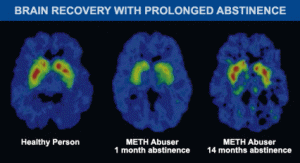ARTICLE OVERVIEW: During crystal meth detoxification, methamphetamine leaves the body and manifests a series of typical withdrawal symptoms. You can expect extreme fatigue, depression, and even hallucinations if you’ve been a heavy user. More on the psychological and emotional support during this time with a section at the end about getting help.
TABLE OF CONTENTS
- Brain Changes
- Why Withdrawal HOccurs
- Duration
- Symptoms
- Protracted Symptoms
- Withdrawal Timeline
- Main Treatments
- Medications That Help
- Tapering
- Why Detox In A Clinic?
- Detox At Home?
- Use Patterns
- Ricks of Use
- Dependence VS Addiction: Differences
- Your Questions
Brain Changes
Methamphetamine (Meth) is a stimulant drug usually used as a white, bitter-tasting powder or a pill. Crystal methamphetamine is a form of the drug that looks like glass fragments or shiny, bluish-white rocks. It is chemically similar to amphetamine, a drug used to treat attention-deficit hyperactivity disorder (ADHD) and narcolepsy (a sleep disorder). [1]
How do people use methamphetamine? People can take methamphetamine by:
- Inhaling or smoking it.
- Injecting the powder that has been dissolved in water/alcohol.
- Snorting.
- Swallowing the cooked rocks.
Because the “high” from the drug both starts and fades quickly, people often take repeated doses in a “binge and crash” pattern. In some cases, people take methamphetamine in a form of binging known as a “run,” giving up food and sleep while continuing to take the drug every few hours for up to several days.
How does methamphetamine affect the brain? Methamphetamine increases the amount of the natural chemical dopamine in the brain. Dopamine is involved in body movement, motivation, pleasure, and reward (pleasure from natural behaviors such as eating). The drug’s ability to release high levels of dopamine rapidly in reward areas of the brain produces the “rush” (euphoria) or “flash” that many people experience.
In addition, continued methamphetamine use causes changes in the brain’s dopamine system that are associated with reduced coordination and impaired verbal learning. In studies of people who used methamphetamine over the long term, severe changes also affected areas of the brain involved with emotion and memory. This may explain many of the emotional and cognitive problems observed in those who use methamphetamine.
Why Withdrawal Occurs
Withdrawal happens after the brain develops physical dependence on meth. What is drug dependence? Mainly, it’s a brain adaptation…
If you’re taking crystal meth regularly, the brain has to adapt in order to survive. To do so, it produces depressant effects to counter-balance the stimulants found in meth. And after time, the chemical state becomes the new “normal”. Remove the drug, and it takes time for the “depressant” effects of the central nervous system to cease and for the brain to balance out again.
To put it another way, according to the National Institute on Drug Abuse, dependence…
“Develops when the [brain’s] neurons adapt to the repeated drug exposure and only function normally in the presence of the drug. When the drug is withdrawn, several physiologic reactions occur. These can be mild… or even life threatening.”[2]
Meth dependence is especially harmful, this 2010 study published in the journal Addiction Behaviors stated that crystal meth dependence may be associated with decreased everyday functioning ability. Many experts think that meth is so strong that it alters the frontal cortex of the brain in a dysfunctional way. But that’s not all. [3]
Meth also triggers psychopathology related to chronic drug use. Physiological dependence associated withdrawal-related symptoms and craving are thought to reinforce continued drug taking. An understanding of methamphetamine withdrawal may therefore inform the development of strategies for relapse prevention.
The acute phase of crystal meth withdrawal peaks around Day 2 or 3 after last use and generally begins to ease after a week to 10 days.
Duration
How long does crystal meth withdrawal take? It depends. The course of withdrawal depends on the person’s severity of methamphetamine dependence, which is based on how long and how often the person has used. Some users will experience the full-blown withdrawal syndrome immediately when they stop using, with acute symptoms that last for a few weeks. Less extreme cases of withdrawal may resolve within a few days.
Although the duration of withdrawal varies between people, the acute phase of withdrawal can peak around day two or three after last use and generally begins to ease after a week to 10 days.
Normally, the crystal meth withdrawal phase lasts 7-10 days, and users may experience excessive hunger, strong drug cravings, and depression. Usually these symptoms decline 1-2 weeks after the last crystal meth dose (although intense cravings can last for months later). Low-grade symptoms including mood swings and agitation, cravings, and sleep disturbance can last for a further couple of weeks; however, for some people, depression can last from weeks to many months or even a year in severe cases.
Symptoms
Crystal meth is highly addictive. When people stop taking it, withdrawal symptoms can include:
- Anxiety.
- Fatigue.
- Intense cravings.
- Psychosis.
- Severe depression.
According to NIDA, Some of the neurobiological effects of chronic methamphetamine abuse appear to be at least partially reversible. For example, people who quit meth for more than a year show improved performance on motor and verbal memory tests. But function in other brain regions did not recover even after 14 months of abstinence. This indicates that some brain changes caused by meth use are very long lasting. [4]
Protracted Symptoms
Depressive and psychotic symptoms of meth withdrawal typically resolve within 1 week after quitting. However, craving is also present during this time and lasts at least 5 weeks. This is why people are so prone to relapse.
Even more, some “protracted” or “post-acute” symptoms of withdrawal can linger in the weeks, months, and years after you quit. That’s how powerful meth is! Some of the protracted withdrawal symptoms (PAWS) of crystal meth include:
- Anxiety.
- Deficits in executive control functions of the brain.
- Depression.
- Difficulties concentrating.
- Difficulties thinking.
- Fatigue.
- Hostility.
- Insomnia.
- Irritability.
- Mood instability.
- Reduced interest in sex.
- Unexplained physical complaints, especially of pain.
Although some brain changes may reverse after being off the drug for a year or more, other changes may not recover even after a long period of abstinence. A recent study even suggests that people who used methamphetamine have an increased the risk of developing Parkinson’s disease, a disorder of the nerves that affects movement.
Moreover, methamphetamine use can increase one’s risk of stroke, which can cause irreversible damage to the brain.
Withdrawal Timeline
The timeline of withdrawal can vary from person to person. Nevertheless, the acute withdrawal symptoms last about 1–2 weeks, on average.
Days 1-3: Symptoms may begin as early as a few hours after the last dose and may gradually worsen over the next few days before beginning to improve. Within a few hours after the last dose, depressed mood may begin to set in as the drug wears off. After one-day, withdrawal symptoms begin when the person has failed to consume meth for roughly twenty-four hours. He will usually experience extreme fatigue and sleep more than is normal. He may also begin to feel depressed.
Days 4-10: Between four to ten days withdrawal symptoms peak during this time, causing the person to experience strong cravings, mood swings, and difficulty concentrating. This is when they are most likely to consider a return to meth use, especially if they experience severe withdrawal symptoms like paranoia, hallucinations, and extreme anxiety.
Weeks 2-4: Within eleven to thirty days, the person usually continues to struggle with strong cravings and feelings of depression. This is further compounded by their struggles with insomnia. After about one month of abstinence, withdrawal symptoms begin to lift, allowing the person to finally start feeling a bit better. However, the person continues to require close support, as cravings and some feelings of depression can persist.
Main Treatments
While research is under way, there are currently no government-approved medications to treat methamphetamine addiction. The most effective treatments for methamphetamine addiction so far are behavioral therapies, such as:
Cognitive-behavioral therapy, which helps persons recognize, avoid, and cope with the situations in which they are most likely to use drugs.
Motivational incentives, which uses vouchers or small cash rewards to encourage persons to remain drug-free.
Still, “detoxification” is defined as a broad process, and three essential components can be described that can take place simultaneously or as a series of steps:
STEP 1. Encouraging the person’s entry into treatment involves preparing them for the long haul. You need to explain the length of treatment and the course of detox…followed by the need for rehab.
STEP 2: An evaluation involves drug testing, the measurement of their concentration and the detection of concurrent mental and physical disorders. The evaluation step also includes a comprehensive assessment of the person’s medical and psychological conditions and social situation to help determine the appropriate level of treatment after detoxification. Essentially, the evaluation serves as the basis for the initial treatment plan for substance abuse once the person has been successfully removed.
STEP 3: Stabilization includes the medical and psychosocial processes of helping the person through acute intoxication and withdrawal to achieve a medically stable, fully compatible and substance-free state. This is often done with the help of medications, although in some approaches to detoxification no medication is used. Stabilization includes familiarizing people with what to expect in the treatment environment and their role in treatment and recovery. During this time, professionals also seek the participation of family members, and other significant persons when appropriate and with the release of confidentiality.
The three components (evaluation, stabilization and promotion of entry into treatment) involve treating the person with compassion and understanding. People undergoing detoxification need to know that someone cares about them, respects them as persons and has hope for their future. The measures taken during the detoxification will show the person that the recommendations of the provider can be reliable and followed.
Medications that Help
The FDA does not currently approve of any specific medications for the treatment of crystal meth addiction. Supportive medications, however, are meant to be used alongside therapy to help ease the intensity of the detoxification process, which typically includes a range of uncomfortable withdrawal symptoms. When withdrawal is supervised by professionals, the person can usually receive medication treatment to soften the symptoms of both short-term detoxification and long-term psychological withdrawal.
Medicines that may reduce meth cravings include:
Buproprion: This drug has been correlated with reduced meth cravings.
Dextroamphetamine: While this drug has not been shown to affect meth use, it has been shown to reduce meth cravings. Dextroamphetamine is itself an addictive stimulant, but is available as a prescription tablet, potentially facilitating closer medical vigilance and safer dosing while mitigate cravings.
Nicotine: Nicotine administration during meth withdrawal has show to reduce meth-seeking behavior in some persons.
Naltrexone: Studies on naltrexone have appeared to reduce meth-seeking behavior a possible indicator of its ability to reduce meth cravings.
Rivastigmine: Studies have suggested this drug might help reduce meth users’ desire for meth.
Research has been starting to show some specific medications that may become approved by the FDA in the near future for their abilities to help treat meth addiction. Trial studies have been performed with many medications believed to possibly enhance long-term recovery success. However, more studies will be needed to confirm drug efficacy in the treatment of meth addiction, and each person’s response to a given medication may somewhat vary.
Medicines that may reduce meth use include:
Buproprion: This drug may reduce meth use in light meth users only.
Mirtazapine: One study found that mirtazapine (alongside cognitive-behavioral therapy) was associated with significant reductions in meth use among a sample of men who have sex with men (MSM).
Modafinil: This drug shows mixed results. One study has suggested that this drug – when combined with cognitive-behavioral therapy – may help reduce meth use. Other studies have not shown a lot of promise for this drug.
Naltrexone: More than one study have suggested that this drug has potential for reducing use and increasing abstinence of methamphetamine.
Topiramate: One study found topiramate to reduce overall meth use. Total abstinence from meth was not observed in conjunction with taking topiramate, however.
Along with these promising medications, some researchers have also been working steadily on immunological treatments. This kind of treatment involves engineering antibodies to target methamphetamine in the bloodstream and bond to the molecules of meth. Researchers hope that this method could help halt meth overdose and other dangerous effects meth has on the brain and other organs. It would also negate the pleasurable rush of the drug.
Tapering
The most successful method in treating crystal meth dependence involves abstinence from taking the drug completely, or a method known as “cold turkey”. This is because tapered use proves unhelpful, given the long duration of meth’s action on the central nervous system. Cold turkey meth detox involves an immediate and abrupt cessation of meth.
Why Detox In A Clinic?
Crystal meth is highly addictive drug, so qualitative medical supervision is usually required. This is why experts do not usually recommend that the person detox from crystal meth at home. Moreover, persons undergoing crystal meth detox need to know that someone cares for them, and respects them. Close family members and friends can also be included in the counseling therapy giving support to crystal meth abusers.
Crystal meth detox clinics can also employ different models of treatment like social and medical, and a huge variety of outpatient or residential programs. Still, crystal meth detox usually takes place in special detoxification clinics whose medical staff monitors crystal meth users’ state 24/7, administering tests, and helping them to withdraw successfully.
Detox At Home?
Because crystal meth detox is not medically dangerous and there are no formal medical complications, crystal meth users can detox at home unless they are suffer from extreme depression and a danger to themselves and others. Additionally, if risk of relapse at home is high, it is best to seek medical supervision during this time.
Who Uses Crystal Meth?
Crystal methamphetamine is used by persons of all ages and is increasingly gaining in popularity as a club drug. It is difficult to determine how many people in the United States use crystal methamphetamine because most illicit drug use surveys do not distinguish between crystal methamphetamine and powdered methamphetamine.
Those surveys that do draw such a distinction reveal that use of crystal methamphetamine is prevalent. According to the University of Michigan’s Monitoring the Future Survey, nearly 5 percent of high school seniors in the United States used crystal methamphetamine at least once in their lifetime and 3 percent used the drug in the past year. [5]
Risks of Use
Taking even small amounts of methamphetamine can result in many of the same health effects as those of other stimulants, such as cocaine or amphetamines. These include:
- Decreased appetite.
- Faster breathing.
- Increased blood pressure and body temperature.
- Increased wakefulness and physical activity.
- Rapid and/or irregular heartbeat.
Long-term methamphetamine use has many other negative consequences, including:
- Anxiety.
- Confusion.
- Extreme weight loss.
- Hallucinations (sensations and images that seem real though they are not).
- Intense itching, leading to skin sores from scratching.
- Paranoia (extreme and unreasonable distrust of others).
- Severe dental problems (“meth mouth”).
- Sleeping problems.
- Violent behavior.
Methamphetamine use can also alter judgment and decision-making leading to risky behaviors, such as unprotected sex, which also increases risk for infection.
People who inject methamphetamine are at increased risk of contracting infectious diseases such as HIV and hepatitis B and C. These diseases are transmitted through contact with blood or other bodily fluids. Methamphetamine use may also worsen the progression of HIV/AIDS and its consequences. Studies indicate that HIV causes more injury to nerve cells and more cognitive problems in people who have HIV and use methamphetamine than it does in people who have HIV and do not use the drug. Cognitive problems are those involved with thinking, understanding, learning, and remembering.
Dependence VS Addiction: Differences
The words dependence and addiction are often used interchangeably, but there are important differences between the two.
Dependence is caused by changes in the body as a result of constant exposure to a drug; it refers to a physical condition where the body has become accustomed to the presence of a drug. If a person with methamphetamine dependence suddenly stops taking it, that person will experience withdrawal symptoms, such as those already explained.
According to the National Institute on Drug Abuse (NIDA), addiction is:
“A recurrent and chronic brain disease that is characterized by the search and compulsive use of drugs, despite the harmful consequences.”
In other words, addiction is an uncontrollable or overwhelming need to use a medication or substance. Repeated exposure to these drugs can trick the brain into giving priority to taking drugs over normal, healthy activities. The treatment of addiction is likewise complex and requires medical attention, behavioral counseling, and long-term support to prevent relapse.
Drug addiction is a dangerous and often fatal condition, and it can be virtually impossible for an addicted person to break the cycle of compulsive drug use without assistance. Fortunately, there are many effective professional treatment programs that can help.
Crystal Meth Detoxification Questions
Did we answer most of your questions about detox? We hope so. If you have additional concerns about crystal meth or the detox process, please share them in the comments section below. We will do our best to respond to you as soon as possible.












Related Posts